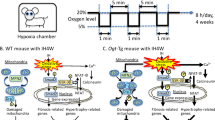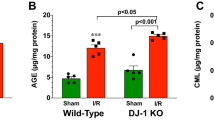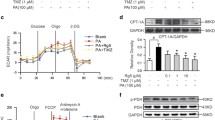Abstract
O-linked β-N-acetylglucosamine (O-GlcNAc) is an inducible, dynamically cycling and reversible post-translational modification of Ser/Thr residues of nucleocytoplasmic and mitochondrial proteins. We recently discovered that O-GlcNAcylation confers cytoprotection in the heart via attenuating the formation of mitochondrial permeability transition pore (mPTP) and the subsequent loss of mitochondrial membrane potential. Because Ca2+ overload and reactive oxygen species (ROS) generation are prominent features of post-ischemic injury and favor mPTP formation, we ascertained whether O-GlcNAcylation mitigates mPTP formation via its effects on Ca2+ overload and ROS generation. Subjecting neonatal rat cardiac myocytes (NRCMs, n ≥ 6 per group) to hypoxia, or mice (n ≥ 4 per group) to myocardial ischemia reduced O-GlcNAcylation, which later increased during reoxygenation/reperfusion. NRCMs (n ≥ 4 per group) infected with an adenovirus carrying nothing (control), adenoviral O-GlcNAc transferase (adds O-GlcNAc to proteins, AdOGT), adenoviral O-GlcNAcase (removes O-GlcNAc to proteins, AdOGA), vehicle or PUGNAc (blocks OGA; increases O-GlcNAc levels) were subjected to hypoxia–reoxygenation or H2O2, and changes in Ca2+ levels (via Fluo-4AM and Rhod-2AM), ROS (via DCF) and mPTP formation (via calcein-MitoTracker Red colocalization) were assessed using time-lapse fluorescence microscopy. Both OGT and OGA overexpression did not significantly (P > 0.05) alter baseline Ca2+ or ROS levels. However, AdOGT significantly (P < 0.05) attenuated both hypoxia and oxidative stress-induced Ca2+ overload and ROS generation. Additionally, OGA inhibition mitigated both H2O2-induced Ca2+ overload and ROS generation. Although AdOGA exacerbated both hypoxia and H2O2-induced ROS generation, it had no effect on H2O2-induced Ca2+ overload. We conclude that inhibition of Ca2+ overload and ROS generation (inducers of mPTP) might be one mechanism through which O-GlcNAcylation reduces ischemia/hypoxia-mediated mPTP formation.










Similar content being viewed by others
References
Akao M, Ohler A, O’Rourke B, Marban E (2001) Mitochondrial ATP-sensitive potassium channels inhibit apoptosis induced by oxidative stress in cardiac cells. Circ Res 88:1267–1275
Ambrosio G, Becker LC, Hutchins GM, Weisman HF, Weisfeldt ML (1986) Reduction in experimental infarct size by recombinant human superoxide dismutase: insights into the pathophysiology of reperfusion injury. Circulation 74:1424–1433
Bernardi P, Scorrano L, Colonna R, Petronilli V, Di Lisa F (1999) Mitochondria and cell death. Mechanistic aspects and methodological issues. Eur J Biochem 264:687–701
Bueno OF, De Windt LJ, Tymitz KM, Witt SA, Kimball TR, Klevitsky R, Hewett TE, Jones SP, Lefer DJ, Peng CF, Kitsis RN, Molkentin JD (2000) The MEK1-ERK1/2 signaling pathway promotes compensated cardiac hypertrophy in transgenic mice. EMBO J 19:6341–6350
Champattanachai V, Marchase RB, Chatham JC (2007) Glucosamine protects neonatal cardiomyocytes from ischemia–reperfusion injury via increased protein-associated O-GLcNAc. Am J Physiol Cell Physiol 292:C178–C187
Champattanachai V, Marchase RB, Chatham JC (2008) Glucosamine protects neonatal cardiomyocytes from ischemia–reperfusion injury via increased protein O-GLcNAc and increased mitochondrial Bcl-2. Am J Physiol Cell Physiol 294:C1509–C1520
Chi L, Tamura Y, Hoff PT, Macha M, Gallagher KP, Schork MA, Lucchesi BR (1989) Effect of superoxide dismutase on myocardial infarct size in the canine heart after 6 hours of regional ischemia and reperfusion: a demonstration of myocardial salvage. Circ Res 64:665–675
Condorelli G, Roncarati R, Ross J Jr, Pisani A, Stassi G, Todaro M, Trocha S, Drusco A, Gu Y, Russo MA, Frati G, Jones SP, Lefer DJ, Napoli C, Croce CM (2001) Heart-targeted overexpression of caspase3 in mice increases infarct size and depresses cardiac function. Proc Natl Acad Sci USA 98:9977–9982
Crompton M (1999) The mitochondrial permeability transition pore and its role in cell death. Biochem J 341:233–249
Crompton M, Costi A, Hayat L (1987) Evidence for the presence of a reversible Ca2+-dependent pore activated by oxidative stress in heart mitochondria. Biochem J 245:915–918
Crow MT, Mani K, Nam YJ, Kitsis RN (2004) The mitochondrial death pathway and cardiac myocyte apoptosis. Circ Res 95:957–970
Di Lisa F (2001) Mitochondrial contribution in the progression of cardiac ischemic injury. IUBMB Life 52:255–261
Di Lisa F, Menabo R, Canton M, Barile M, Bernardi P (2001) Opening of the mitochondrial permeability transition pore causes depletion of mitochondrial and cytosolic NAD+ and is a causative event in the death of myocytes in postischemic reperfusion of the heart. J Biol Chem 276:2571–2575
Fulop N, Marchase RB, Chatham JC (2007) Role of protein O-linked N-acetyl-glucosamine in mediating cell function and survival in the cardiovascular system. Cardiovasc Res 73:288–297
Girffiths EJ, Halestrap AP (1995) Mitochondrial non-specific pores remain closed during cardiac ischaemia, but open upon reperfusion. Biochem J 307:93–98
Girod WG, Jones SP, Sieber N, Aw TY, Lefer DJ (1999) Effects of hypercholesterolemia on myocardial ischemia–reperfusion injury in LDL receptor-deficient mice. Arterioscler Thromb Vasc Biol 19:2776–2781
Halestrap AP (2004a) Does the mitochondrial permeability transition have a role in preconditioning? Circulation 110:e303 (author reply e303)
Halestrap AP (2004b) The mitochondrial permeability transition pore in reperfusion injury and cardioprotection. Cardiovasc J S Afr 15:S5
Halestrap AP (2006) Calcium, mitochondria and reperfusion injury: a pore way to die. Biochem Soc Trans 34:232–237
Haltiwanger RS, Grove K, Philipsberg GA (1998) Modulation of O-linked N-acetylglucosamine levels on nuclear and cytoplasmic proteins in vivo using the peptide O-GLcNAc-beta-N-acetylglucosaminidase inhibitor O-(2-acetamido-2-deoxy-d-glucopyranosylidene)amino-N-phenylcarbamate. J Biol Chem 273:3611–3617
Hoffmeyer MR, Scalia R, Ross CR, Jones SP, Lefer DJ (2000a) PR-39, a potent neutrophil inhibitor, attenuates myocardial ischemia–reperfusion injury in mice. Am J Physiol Heart Circ Physiol 279:H2824–H2828
Hoffmeyer MR, Jones SP, Ross CR, Sharp B, Grisham MB, Laroux FS, Stalker TJ, Scalia R, Lefer DJ (2000b) Myocardial ischemia/reperfusion injury in NADPH oxidase-deficient mice. Circ Res 87:812–817
Housley MP, Udeshi ND, Rodgers JT, Shabanowitz J, Puigserver P, Hunt DF, Hart GW (2009) A PGC-1alpha-O-GLcNAc transferase complex regulates FoxO transcription factor activity in response to glucose. J Biol Chem 284:5148–5157
Hunter DR, Haworth RA (1979) The Ca2+-induced membrane transition in mitochondria. III. Transitional Ca2+ release. Arch Biochem Biophys 195:468–477
Jones SP, Girod WG, Granger DN, Palazzo AJ, Lefer DJ (1999a) Reperfusion injury is not affected by blockade of P-selectin in the diabetic mouse heart. Am J Physiol 277:H763–H769
Jones SP, Girod WG, Palazzo AJ, Granger DN, Grisham MB, Jourd’Heuil D, Huang PL, Lefer DJ (1999b) Myocardial ischemia–reperfusion injury is exacerbated in absence of endothelial cell nitric oxide synthase. Am J Physiol 276:H1567–H1573
Jones SP, Trocha SD, Strange MB, Granger DN, Kevil CG, Bullard DC, Lefer DJ (2000) Leukocyte and endothelial cell adhesion molecules in a chronic murine model of myocardial reperfusion injury. Am J Physiol Heart Circ Physiol 279:H2196–H2201
Jones SP, Trocha SD, Lefer DJ (2001a) Pretreatment with simvastatin attenuates myocardial dysfunction after ischemia and chronic reperfusion. Arterioscler Thromb Vasc Biol 21:2059–2064
Jones SP, Trocha SD, Lefer DJ (2001b) Cardioprotective actions of endogenous IL-10 are independent of iNOS. Am J Physiol Heart Circ Physiol 281:H48–H52
Jones SP, Girod WG, Marotti KR, Aw TY, Lefer DJ (2001c) Acute exposure to a high cholesterol diet attenuates myocardial ischemia–reperfusion injury in cholesteryl ester transfer protein mice. Coron Artery Dis 12:37–44
Jones SP, Gibson MF, Rimmer DM 3rd, Gibson TM, Sharp BR, Lefer DJ (2002) Direct vascular and cardioprotective effects of rosuvastatin, a new HMG-CoA reductase inhibitor. J Am Coll Cardiol 40:1172–1178
Jones SP, Hoffmeyer MR, Sharp BR, Ho YS, Lefer DJ (2003a) Role of intracellular antioxidant enzymes after in vivo myocardial ischemia and reperfusion. Am J Physiol Heart Circ Physiol 284:H277–H282
Jones SP, Greer JJ, van Haperen R, Duncker DJ, de Crom R, Lefer DJ (2003b) Endothelial nitric oxide synthase overexpression attenuates congestive heart failure in mice. Proc Natl Acad Sci USA 100:4891–4896
Jones SP, Teshima Y, Akao M, Marban E (2003c) Simvastatin attenuates oxidant-induced mitochondrial dysfunction in cardiac myocytes. Circ Res 93:697–699
Jones SP, Greer JJ, Kakkar AK, Ware PD, Turnage RH, Hicks M, Van Haperen R, De Crom R, Kawashima S, Yokoyama M, Lefer DJ (2004) Endothelial nitric oxide synthase overexpression attenuates myocardial reperfusion injury. Am J Physiol Heart Circ Physiol 286:H276–H282
Jones SP, Greer JJ, Ware PD, Yang J, Walsh K, Lefer DJ (2005) Deficiency of iNOS does not attenuate severe congestive heart failure in mice. Am J Physiol Heart Circ Physiol 288:H365–H370
Jones SP, Zachara NE, Ngoh GA, Hill BG, Teshima Y, Bhatnagar A, Hart GW, Marban E (2008) Cardioprotection by N-acetylglucosamine linkage to cellular proteins. Circulation 117:1172–1182
Kelly BD, Hackett SF, Hirota K, Oshima Y, Cai Z, Berg-Dixon S, Rowan A, Yan Z, Campochiaro PA, Semenza GL (2003) Cell type-specific regulation of angiogenic growth factor gene expression and induction of angiogenesis in nonischemic tissue by a constitutively active form of hypoxia-inducible factor 1. Circ Res 93:1074–1081
Kilgore KS, Friedrichs GS, Johnson CR, Schasteen CS, Riley DP, Weiss RH, Ryan U, Lucchesi BR (1994) Protective effects of the SOD-mimetic SC-52608 against ischemia/reperfusion damage in the rabbit isolated heart. J Mol Cell Cardiol 26:995–1006
Lefer DJ, Granger DN (2000) Oxidative stress and cardiac disease. Am J Med 109:315–323
Lefer DJ, Scalia R, Jones SP, Sharp BR, Hoffmeyer MR, Farvid AR, Gibson MF, Lefer AM (2001) HMG-CoA reductase inhibition protects the diabetic myocardium from ischemia–reperfusion injury. Faseb J 15:1454–1456
Lemasters JJ, Nieminen AL, Qian T, Trost LC, Elmore SP, Nishimura Y, Crowe RA, Cascio WE, Bradham CA, Brenner DA, Herman B (1998) The mitochondrial permeability transition in cell death: a common mechanism in necrosis, apoptosis and autophagy. Biochim Biophys Acta 1366:177–196
Liu J, Marchase RB, Chatham JC (2007a) Glutamine-induced protection of isolated rat heart from ischemia/reperfusion injury is mediated via the hexosamine biosynthesis pathway and increased protein O-GLcNAc levels. J Mol Cell Cardiol 42:177–185
Liu J, Marchase RB, Chatham JC (2007b) Increased O-GLcNAc levels during reperfusion lead to improved functional recovery and reduced calpain proteolysis. Am J Physiol Heart Circ Physiol 293:H1391–H1399
Lucchesi BR, Werns SW, Fantone JC (1989) The role of the neutrophil and free radicals in ischemic myocardial injury. J Mol Cell Cardiol 21:1241–1251
McCord JM (2000) The evolution of free radicals and oxidative stress. Am J Med 108:652–659
Murata M, Akao M, O’Rourke B, Marban E (2001) Mitochondrial ATP-sensitive potassium channels attenuate matrix Ca2+ overload during simulated ischemia and reperfusion: possible mechanism of cardioprotection. Circ Res 89:891–898
Nagy T, Champattanachai V, Marchase RB, Chatham JC (2006) Glucosamine inhibits angiotensin II-induced cytoplasmic Ca2+ elevation in neonatal cardiomyocytes via protein-associated O-linked N-acetylglucosamine. Am J Physiol Cell Physiol 290:C57–C65
Ngoh GA, Jones SP (2008) New insights into metabolic signaling and cell survival: the role of O-GLcNAc. J Pharmacol Exp Ther 327(3):602–609
Ngoh GA, Watson LJ, Facundo HT, Dillmann W, Jones SP (2008) Non-canonical glycosyltransferase modulates post-hypoxic cardiac myocyte death and mitochondrial permeability transition. J Mol Cell Cardiol 45:313–325
Ngoh GA, Facundo HT, Hamid T, Dillmann W, Zachara NE, Jones SP (2009a) Unique hexosaminidase reduces metabolic survival signal and sensitizes cardiac myocytes to hypoxia/reoxygenation injury. Circ Res 104:41–49
Ngoh GA, Hamid T, Prabhu SD, Jones SP (2009b) O-GlcNAc signaling attenuates ER stress-induced cardiomyocyte death. Am J Physiol Heart Circ Physiol 297:H1711–H1719
Ngoh GA, Facundo HT, Zafir A, Jones SP (2010) O-GlcNAc signaling in the cardiovascular system. Circ Res 107:171–185
Palazzo AJ, Jones SP, Girod WG, Anderson DC, Granger DN, Lefer DJ (1998a) Myocardial ischemia–reperfusion injury in CD18- and ICAM-1-deficient mice. Am J Physiol 275:H2300–H2307
Palazzo AJ, Jones SP, Anderson DC, Granger DN, Lefer DJ (1998b) Coronary endothelial P-selectin in pathogenesis of myocardial ischemia–reperfusion injury. Am J Physiol 275:H1865–H1872
Scalia R, Gooszen ME, Jones SP, Hoffmeyer M, Rimmer DM 3rd, Trocha SD, Huang PL, Smith MB, Lefer AM, Lefer DJ (2001) Simvastatin exerts both anti-inflammatory and cardioprotective effects in apolipoprotein E-deficient mice. Circulation 103:2598–2603
Sharp BR, Jones SP, Rimmer DM, Lefer DJ (2002) Differential response to myocardial reperfusion injury in eNOS-deficient mice. Am J Physiol Heart Circ Physiol 282:H2422–H2426
Teshima Y, Akao M, Li RA, Chong TH, Baumgartner WA, Johnston MV, Marban E (2003a) Mitochondrial ATP-sensitive potassium channel activation protects cerebellar granule neurons from apoptosis induced by oxidative stress. Stroke 34(7):1796–1802
Teshima Y, Akao M, Jones SP, Marban E (2003b) Uncoupling protein-2 overexpression inhibits mitochondrial death pathway in cardiomyocytes. Circ Res 93:192–200
Teshima Y, Akao M, Jones SP, Marban E (2003c) Cariporide (HOE642), a selective Na+-H+ exchange inhibitor, inhibits the mitochondrial death pathway. Circulation 108:2275–2281
Wang G, Liem DA, Vondriska TM, Honda HM, Korge P, Pantaleon DM, Qiao X, Wang Y, Weiss JN, Ping P (2005) Nitric oxide donors protect murine myocardium against infarction via modulation of mitochondrial permeability transition. Am J Physiol Heart Circ Physiol 288:H1290–H1295
Yang J, Jones SP, Suhara T, Greer JJ, Ware PD, Nguyen NP, Perlman H, Nelson DP, Lefer DJ, Walsh K (2003) Endothelial cell overexpression of fas ligand attenuates ischemia–reperfusion injury in the heart. J Biol Chem 278:15185–15191
Yang S, Zou LY, Bounelis P, Chaudry I, Chatham JC, Marchase RB (2006) Glucosamine administration during resuscitation improves organ function after trauma hemorrhage. Shock 25:600–607
Zachara NE, O’Donnell N, Cheung WD, Mercer JJ, Marth JD, Hart GW (2004) Dynamic O-GlcNAc modification of nucleocytoplasmic proteins in response to stress: a survival response in mammalian cells. J Biol Chem 279:30133–30142
Zou L, Yang S, Hu S, Chaudry IH, Marchase RB, Chatham JC (2007) The protective effects of PUGNAc on cardiac function after trauma-hemorrhage are mediated via increased protein O-GLcNAc levels. Shock 27:402–408
Zou L, Yang S, Champattanachai V, Hu S, Chaudry IH, Marchase RB, Chatham JC (2009) Glucosamine improves cardiac function following trauma-hemorrhage by increased protein O-GLcNAcylation and attenuation of NF-{kappa}B signaling. Am J Physiol Heart Circ Physiol 296:H515–H523
Conflict of interest
None of the authors have any conflicts to declare.
Author information
Authors and Affiliations
Corresponding author
Rights and permissions
About this article
Cite this article
Ngoh, G.A., Watson, L.J., Facundo, H.T. et al. Augmented O-GlcNAc signaling attenuates oxidative stress and calcium overload in cardiomyocytes. Amino Acids 40, 895–911 (2011). https://doi.org/10.1007/s00726-010-0728-7
Received:
Accepted:
Published:
Issue Date:
DOI: https://doi.org/10.1007/s00726-010-0728-7




